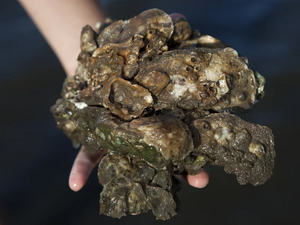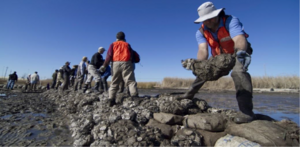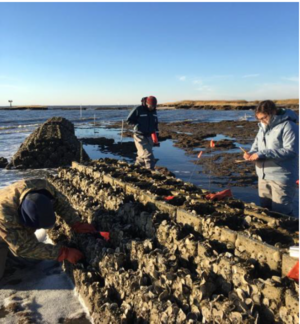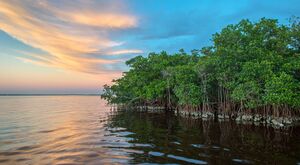Course:CONS200/2023/Restoration of oyster reefs in estuaries
Oysters (bivalve mollusks) are a widely used resource for food and industrial raw material processes. The estuary has excellent hydrological conditions for oyster production, over hundreds of years, it supplies food resources to indigenous communities as well as the location of the oyster farming industry[1]. Oysters adhere shells to other objects, in which these objects covered by a considerable number of oysters on the surface are collectively named the oyster reef[2]. The abundance and distribution of oyster species are affected by biotic and abiotic aquatic factors [3].
Global Population Decline
Like overfishing and climate change, many human and non-human factors play important roles in accelerating the global decline of oyster diversity and population. As more and more people perceived the global oyster reef decline as a danger to their wellbeings and lives, a raise in public efforts and scientific research into oyster reef restoration was introduced[4].

Human and Environmental Challenges to Oyster Restoration
After the 1950s, the human impact on nature increased dramatically and industrial emissions of carbon dioxide increased exponentially, thus accelerating global climate change and posing enormous challenges. What's more, the globalization of trade has led to a certain expansion of local markets and increased demand for the exploitation of local resources, resulting in pollution and overexploitation that has led to a steady decline in oyster populations.
- Unsustainable Harvesting: Dredging and tong harvesting methods can damage oyster reefs, taking decades to recover and diminishing habitats for young fish and crabs. The continual dredging of Atlantic Coast estuaries has led to a significant loss of three-dimensional reef structures. Overfishing has reduced many oyster reefs to a thin layer close to the seabed, while oysters thrive and grow faster on top of reef structures.[5]
- Pollution: Oysters can be significantly harmed by various pollutants that are being discharged into estuaries and coasts due to industrial, agricultural, and urban activities. Examples of such pollutants include sulphate leachate and hydrocarbons, and they can have a direct, detrimental effect on oysters.[6]
- Climate Change: Since 1971, the average global ocean temperatures have risen by approximately 0.11°C per decade. This temperature increase has led to a rise in mortality rates of various native species, including the species mentioned, particularly in regions closer to the equator.[6] Moreover, climate change may induce a secondary challenge of species invasion, which increases the complexity of managing and restoring the oyster population.
Research status on Oyster Reef Restoration
85% of the world's oyster reefs have degraded and disappeared over the past century[7]. Both biotic and abiotic conditions separately and synergistically contributed to this process[3]. A lot of research has developed a detailed analysis of these biotic and abiotic conditions, such as overfishing, water pollution, hearing waves pollution, coastal zone development, oyster disease, artificial species invasion, and climate change[3][7]. However, due to the lack of systematic investigation and data, the distribution, status, and threat level of domestic oyster reefs are mostly unknown, which has caused great difficulties in the protection, restoration, and sustainable use of oyster reef resources[7].
Ecological restoration of oyster reefs was a hot spot in the early stage of international oyster reef research[8]. Many research results have been accumulated before 2008, among them, the Chesapeake Bay in the United States was the first area to carry out the practice of oyster reef ecological restoration[8]. With the efforts of a large number of academic workers and ecological protection organizations, the research on the ecological restoration of oyster reefs has gradually deepened, and it is still a hot spot in oyster reef research[8].
Declined Ecological Function
Habitat for other species
Oyster reefs provide a natural structure that offers hiding places for fish and crabs, helping them to evade predators. Smaller forage species can also thrive in the crevices created by oyster reefs. Many of the species that inhabit oyster reefs are commercially and recreationally valuable.[5][6]
Water quality
Oysters have the ability to make water healthier. They act as natural filters by feeding on algae in the water, which improves water quality and reduces nutrient overload. With their remarkable filtration capacity, a single oyster can filter up to 50 gallons of water per day.[5]
Prerequisites of Restoration
Prior to any implantation, the site must be verified and deemed viable before projects can be commenced.
- Find sites with enough resources: In order to commence any restoration efforts regarding the oyster reef decline, viable locations hold enough resources to ensure continued growth. In most instances, restoration efforts in the past were deemed successful by comparing an ecosystem's level of degradation and damage to the relative closeness that the ecosystem gets to its original state[4]. Finding such locations take time and resources to locate, but of helps ensure that the ecosystem remains undisturbed save for external and randomized factors.
- Select environment-tolerant oyster species: These locations must also meet specific requirements in order to facilitate optimal growth, such as meeting conditions to ensure oyster survival, growth, and reproduction, the presence of hard substrate on which reefs can accrete, and adequate larval supply to support reef growth[4]. Finding viable locations are only the first step, as there are a multitude of additional factors that must be addressed in order to ensure the survivability of the reefs. Also, site selection requires knowledge of the environmental tolerances of the oyster species to be restored and the range of conditions across which its reefs provide desired ecosystem services[4].
- Calculate impacts from human activities: Locations that have been subject to human modifications have been shown to have developed qualities that qualify the location to be viable for an oyster reef. As an example, coastal lagoon entrances that are now permanently trained open for flood mitigation or navigation have transformed waterways that historically had insufficient water flux to support oyster filter-feeding but may now be suitable locations for oyster growth[4]. This shows that viable locations and sites can also be developed artificially, but the current remains only as an option behind sites that are naturally occurring in order to create a more organic and natural environment for the reefs.
Post-viability Implementations and Methods
After confirming the viability of a specific area restoration plan, any subsequent work can begin. Post-viability is a term to describe all progress that is made after a site is properly researched and confirmed to be appropriate to be a set location for a restoration project of any size. The term is necessary to ensure that a site will not encounter unpredictable events that can cause irreversible damage to both the project and the site. Afterward, the site can be prepared. This involves removing any debris, stabilizing the substrate, and placing a layer of the shell, limestone, or other suitable material across the site[9].
Oyster Seed-Planting Method
Once the site is prepared, the oyster seed can be planted. There are different methods of planting, including the use of mesh bags or cages[8].
Plastic Oyster Shell Bag
In more recent restoration projects, restoration practitioners have opted to use plastic-based materials in order to help constitute the oyster reef habitats in their projects. By doing so, even as the method was previously praised and successful (in terms of oyster recruitment, sediment accretion, etc.) such restoration projects have come under scrutiny for using plastic-based products, in particular, the use of plastic oyster shell bags[9]. The method of using bags is still a topic of contention, as the concern of using inorganic materials in the habitats can pose a threat to the overall health of the reef. And it is widely discussed in areas such as the state of Florida, USA due to the wide range of active restoration partners across the state, the dominance of intertidal oyster reefs, the small-scale nature of most reef and shoreline restoration projects (i.e., <5 acres), and historic heavy reliance on bagged oyster shell[8].

Organic Oyster Shell Bag
The backlash stems from the argument that introducing inorganic materials such as microplastics[8] into the ecosystem will have an eventual detrimental effect to the habitat itself. In lieu of this, states like Florida are actively investigating where non-plastic materials will yield the same benefits and success as plastic options[8]. Such alternatives that are being tested are natural fibers like jute, coconut coir, and hemp, and in recent years, new variations that combine natural fibers with mineral hardeners such as Portland or calcium sufflaminate (CSA) cement have started gaining popularity[8]. The scale of the project also plays an important part in the decision to use organic and inorganic materials in the restoration sites. Resources can only be spread so far before becoming insufficient. For example, in Florida, limestone and coquina have been used as a clutch on some subtidal, large-scale reef restoration projects; no plastic materials are required in this type of design[8]. Depending on the scale, practitioners in the restoration projects must make concessions regarding what resources can be used in the reef sites. As successful as the incorporation of microplastics[8] was in the previous projects, other current and future projects might not share the same scale or have the same levels of site viability to support all methods. Site preparation is complex in that much of the preparation is planning and compromising before any action can be taken.
Constructed reefs

Site-specific projects have different focuses and end goals when it comes to restoration efforts. "Constructed" reefs as those that were anthropogenically enhanced, restored, or created using shell or other materials such as rock or cement, are habitats designed for reef restoration and not oyster production for human consumption[8]. Regardless, once the purpose of the restoration effort has been established, the oyster seeds can be placed in the habitat to commence gestation. The seed should be spaced appropriately to allow for growth and avoid overcrowding. After planting, it is important to monitor the growth and health of the oyster reef. Regular monitoring can help detect any changes in water quality, disease outbreaks, or other environmental factors that may affect the health of the reef. Reefs are often classified as either intertidal or subtidal, and any reef not explicitly identified as intertidal was classified as subtidal, although some subtidal reefs are acknowledged to be occasionally exposed to weather events[8]. Reefs that experience such phenomenon are more closely observed to prevent substantial changes that can occur from such unprecedented occurrences.
Oyster Seed-Planting Monitor
To ensure the long-term success of the oyster reef, it is important to maintain the site. This involves removing any debris or fouling organisms that may accumulate on the shells, as well as periodically adding additional shells to the site to promote growth. If maintained, the reef will begin to see a substantial change to its ecosystem, both in and around the habitat. Previously degraded reefs referred to as "dead reefs"[10] that are chosen and subsequently restored are then renamed "restored reefs"[10]. To elaborate, the term "restored reefs" refers to dead reefs that were assigned to the restoration treatment and subsequently restored to monitor changes in macroinvertebrate communities post-restoration[10]. For monitoring purposes, Live and dead reefs served as positive and negative controls, respectively, to isolate and quantify the effects of restoration on these resident populations[10]. One metric that is closely monitored within the controls, which is the effects of restoration projects as a whole when it comes to invertebrate diversity in the reefs post-restoration[10]. Regarding diversity, there is also the monitoring of the various fish and decapod communities in multiple reefs to ascertain the effects of restoration projects based on the location of said projects. Factors such as mean fish density, gear type, reef type, and total number of fish and crustacean species are observed to better formulate a clearer idea of the state the reefs are post-restoration. Additionally, water clarity, oyster density, oyster shell height, reef thickness, salinity, and dissolved oxygen were identified as predictors of species richness[11]. Any differences measured in these metrics will be key in determining the overall health and success of the restoration efforts on the oyster reefs. Time will also be a determining factor, as even if the restoration projects prove fruitful in the short-term, long-term sustainability in the face of external factors such as weather events and other random and sudden shock events may cause a sudden downturn in the overall health of the reef. Therefore, it is basically a requirement to continuously monitor reef activity, until enough time has passed to properly assert that the reefs are sustainable in post-restoration efforts[10].
Oyster Reef Restoration Benefits
Different restoration projects have different focuses and end goals when it comes to restoration efforts. Effective ecological restoration methods and monitoring can enhance the population size, range, and continuity of oysters. This may potentially improve the benefits oysters provided in the ecosystem, environment, and indeed in economic activities.
- A very intuitive benefit is that the restoration of oyster reefs will increase the value of the oyster reef fishery.
- By reducing water turbidity (i.e. filtering suspended solids) and suppressing nutrient runoff, restored oyster reefs can contribute to the recovery of submerged aquatic vegetation in contaminated estuaries. And oyster reefs located between salt marsh and submerged aquatic vegetation may be important corridors for predator movement between habitats[5][12]. In experimental simulations of the effect of oyster populations on turbidity levels, it was found that oysters were able to reduce local suspended sediment concentrations by nearly an order of magnitude even at relatively low biomass levels. This reduction would lead to an increase in water clarity, which could have a profound effect on the extent of that vegetation in estuaries such as the Chesapeake Bay[13].
- Restored oyster reefs increase the abundance of juvenile fish and have the potential to enhance fish productivity within the estuary. At the same time, the restoration of oyster reefs has led to an increase in oysters, and a certain amount of oysters can create biological structure through vertical upright cluster growth, providing habitat for a variety of densely aggregated invertebrates[14]. Although these species (i.e. oysters, polychaetes, crustaceans and other molluscs other than resident invertebrates) are rarely of commercial or recreational value to fishermen, they are consumed by many valuable finfishes and crustaceans, so restored oyster reefs also indirectly benefit fisheries production[5].
- The landscape setting of oyster reefs also affects other processes, firstly, the restoration of oyster reefs may affect the filtration rate of the watershed and remove seston from the water[15]. Restored oyster reefs can reduce wave energy and erosion of other valuable habitats such as salt marshes and SAV[16]. And, oysters sequester carbon from the water column as they form calcium carbonate shells. As a carbon sink, oyster reef restoration may result in lower concentrations of greenhouse gases[17]. Also, oyster reefs promote denitrification by concentrating fecal deposition, which reduces anthropogenic nitrogen production and promotes greater benthic plant production[18].
6 Prospects for Oyster Reef Restoration
Ecological restoration of oyster reefs has made very significant progress over the past 20 years or so. The establishment of a large number of artificial oyster reefs has been very beneficial to the recovery of oyster populations, the improvement of the aquatic environment and the sustainable development of estuarine fisheries. However, the lack of detailed understanding of oyster reproductive characteristics, disease control and restoration methods and management of oyster reefs has made it difficult to establish a set of scientific and general restoration methods and procedures, which directly hinders and slows down the restoration of oyster reefs in estuaries.

Based on this situation, the relevant personnel should conduct systematic research and work in the following aspects in the future: [2]
- Research on basic biology of oysters, including reproductive techniques, host-pathogen-environment interrelationships, taxonomy and molecular phylogeny, etc.
- To study the key technologies of oyster reef restoration, including substrate composition, reef construction technology (size, shape and spatial configuration) and oyster seed delivery technology.
- To further study the ecological service function of oyster reefs and put forward the scientific basis, especially the service function of oyster reefs for fish and how aquatic animals use oyster reef habitats. On this basis, the ecological service value of oyster reefs, including habitat value and water purification value, should be scientifically evaluated.
- Establish a set of scientific oyster reef restoration procedures, including the selection of restoration sites, preparation of hard substrate, reef construction, oyster placement and cultivation, disease prevention and management, and follow-up monitoring.
- Improve the evaluation criteria for the success of oyster reef restoration and conduct long-term quantitative monitoring of the restored oyster reef populations.
- The existing natural oyster reefs should be protected, and artificial oyster reefs should be constructed in conjunction with relatively large-scale estuarine projects, so as to further contribute to improving the estuarine environment, restoring the structure and function of the ecosystem and maintaining the sustainable development of estuarine fisheries.
References
- ↑ Ogburn, Damian. M.; White, Ian; Mcphee, Daryl. P. (2007). "The disappearance of oyster reefs from eastern australian estuaries-impact of colonial settlement or mudworm invasion". Coastal Management. 35(2-3), 271-287. doi:10.1080/08920750601169618.
- ↑ 2.0 2.1 Quan, W.; Shen, X.; Luo, M.; Chen, Y. (October 2006). "Ecological function and restoration measures of oyster reef in estuarine area". Chinese Ecology Journal. 25(10), 1234. (In Chinese)
- ↑ 3.0 3.1 3.2 Johnson, K. D.; Smee, D. L. (2014). "Predators influence the tidal distribution of oysters (crassostrea virginica)". Marine Biology. 161(7). doi:10.1007/s00227-014-2440-8.
- ↑ 4.0 4.1 4.2 4.3 4.4 Howie, Alice. H.; Bishop, Melanie. J. (August 3, 2021). "Contemporary Oyster Reef Restoration: Responding to a changing world". Frontiers in Ecology and Evolution. 9. doi:10.3389/fevo.2021.689915.
- ↑ 5.0 5.1 5.2 5.3 5.4 "Oyster Reef Habitat". NOAA Fisheries. 02/04/2022. Check date values in:
|date=(help) Cite error: Invalid<ref>tag; name ":6" defined multiple times with different content - ↑ 6.0 6.1 6.2 Howie, A. H.; Bishop, M. J. (2021). "Contemporary oyster reef restoration: Responding to a changing world". Frontiers in Ecology and Evolution. 9. doi:10.3389/fevo.2021.689915.
- ↑ 7.0 7.1 7.2 Beck, M. W.; Brumbaugh, R. D.; Airoldi, L.; Carranza, A.; Coen, L. D.; Crawford, C.; Defeo, O.; Edgar, G. J.; Hancock, B.; Kay, M. C.; Lenihan, H. S.; Luckenbach, M. W.; Toropova, C. L.; Zhang, G.; Guo, X. (2011). "Oyster reefs at risk and recommendations for conservation, restoration, and management". Bioscience. 61(2), 107-116. doi:10.1525/bio.2011.61.2.5.
- ↑ 8.00 8.01 8.02 8.03 8.04 8.05 8.06 8.07 8.08 8.09 8.10 8.11 Lu, Jiang; Yu, Jing (2021). "Current status and hotspot analysis of oyster reef research based on bibliometrics". Sheng Tai Xue Bao. 41(18). doi:10.5846/stxb202104120942.
- ↑ 9.0 9.1 Walters, L. J.; Roddenberry, A.; Crandall, C.; Wayles, J.; Donnelly, M.; Barry, S. C.; Clark, M. W.; Escandell, O.; Hansen, J. C.; Laakkonen, K.; Sacks, P. E. (2022). "The use of non-plastic materials for Oyster Reef and shoreline restoration: Understanding what is needed and where the field is headed". Sustainability. 14(13), 8055. doi:10.3390/su14138055.
- ↑ 10.0 10.1 10.2 10.3 10.4 10.5 La Peyre, M. K.; Marshall, D. A.; Miller, L. S.; Humphries, A. T. (2019). "Oyster reefs in northern gulf of mexico estuaries harbor diverse fish and decapod crustacean assemblages: A meta-synthesis". Frontiers in Marine Science. 6. doi:10.3389/fmars.2019.00666.
- ↑ Searles, A. R.; Gipson, E. E.; Walters, L. J.; Cook, G. S. (2022). "Oyster Reef Restoration facilitates the recovery of macroinvertebrate abundance, diversity, and composition in estuarine communities". Scientific Reports. 12(1). doi:10.1038/s41598-022-11688-6.
- ↑ Micheli, F.; Peterson, C. H. (1999). "Estuarine Vegetated Habitats as Corridors for Predator Movements". Conservation Biology. 13(4), 869–881. doi:10.1046/j.1523-1739.1999.98233.x.
- ↑ Newell, R. I. E.; Koch, E. W. (2004). "Modeling seagrass density and distribution in response to changes in turbidity stemming from bivalve filtration and seagrass sediment stabilization". Estuaries. 27(5), 793–806. doi:10.1007/bf02912041.
- ↑ Lenihan, H. S.; Peterson, C. H.; Byers, J. E.; Grabowski, J. H.; Thayer, G. W.; Colby, D. A. (2001). "CASCADING OF HABITAT DEGRADATION: OYSTER REEFS INVADED BY REFUGEE FISHES ESCAPING STRESS". Ecological Applications. 11(3), 764–782. doi:10.1890/1051-0761(2001)011.
- ↑ Coen, L. D.; Luckenbach, M. W. (2000). "Developing success criteria and goals for evaluating oyster reef restoration: Ecological function or resource exploitation". Ecological Engineering. 15(3–4), 323–343. doi:10.1016/s0925-8574(00)00084-7.
- ↑ Meyer, D. A.; Townsend, E. R.; Thayer, G. W. (1997). "Stabilization and Erosion Control Value of Oyster Cultch for Intertidal Marsh". Restoration Ecology. 5(1), 93–99. doi:10.1046/j.1526-100x.1997.09710.x.
- ↑ Peterson, C. H.; Lipcius, R. N. (2003). "Conceptual progress towards predicting quantitative ecosystem benefits of ecological restorations". Marine Ecology Progress Series. 264, 297–307. doi:10.3354/meps264297.
- ↑ Newell, R. I. E.; Cornwell, J. C.; Owens, M. J. (2002). "Influence of simulated bivalve biodeposition and microphytobenthos on sediment nitrogen dynamics: A laboratory study". Limnology and Oceanography. 47(5), 1367–1379. doi:10.4319/lo.2002.47.5.1367.
| This conservation resource was created by Course:CONS200. It is shared under a CC-BY 4.0 International License. |
